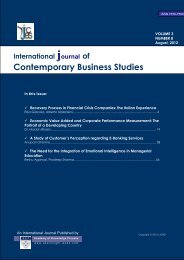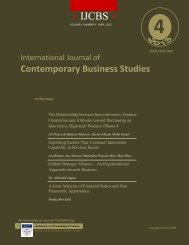Article-PDF - Academy of Knowledge Process - Webs
Article-PDF - Academy of Knowledge Process - Webs
Article-PDF - Academy of Knowledge Process - Webs
You also want an ePaper? Increase the reach of your titles
YUMPU automatically turns print PDFs into web optimized ePapers that Google loves.
International Journal <strong>of</strong> Contemporary Business Studies<br />
Vol: 4, No: 6 JUNE, 2013 ISSN 2156-7506<br />
Available online at http://w w w.akpinsight.webs.com<br />
Table 4.1: Demographical Pr<strong>of</strong>ile <strong>of</strong> Respondents<br />
Gender Frequency Percent<br />
Male 32 63<br />
Female 19 37<br />
Marital Status Frequency Percent<br />
Married 41 80<br />
Unmarried 10 20<br />
Age Pr<strong>of</strong>ile Frequency Percent<br />
Below 30 18 35<br />
30-40 22 43<br />
40-55 8 16<br />
55-70 3 6<br />
Income Frequency Percent<br />
Below 3k 18 35<br />
3k-5k 21 41<br />
5k-10 9 18<br />
Above 10k 3 6<br />
Type <strong>of</strong> Account Frequency Percent<br />
Saving 11 22<br />
Current 40 78<br />
Banking Relationship Frequency Percent<br />
7 yrs<br />
1 2<br />
Page | 77<br />
4.2 Reliability Test<br />
According to George & Mallery (2003), reliability is the degree to which measure are free from<br />
error and therefore yield consistent results. The reliability <strong>of</strong> a measure indicates the stability and<br />
consistency with which the instrument measures the concept and helps to assess the „goodness‟<br />
<strong>of</strong> a measure (Cavana, Delahaye and Sekaran, 2001). According to Sekaran (2003), the closer the<br />
reliability coefficient gets to 1.0, the better it is, and those values over .80 are considered as<br />
good. Those values in the .70 is considered as acceptable and those reliability value less than .60<br />
is considered to be poor (Sekaran, 2003). All the constructs were tested for the consistency<br />
reliability <strong>of</strong> the items within the constructs by using Cronbach‟s alpha reliability analysis.<br />
Cronbach‟s Alpha values in respect <strong>of</strong> each variable are given in table 4.2 below. Respondents<br />
were also assured about the confidentiality as information shared in this regard would be used for<br />
academic and research purposes only. In conclusion, the results showed that the scores <strong>of</strong> the<br />
Cronbach‟s alpha for all the constructs exceeded the threshold <strong>of</strong> 0.70 indicating that the<br />
measurement scales <strong>of</strong> the constructs were stable and consistent.<br />
C opyright © 2 0 13. A cademy <strong>of</strong> <strong>Knowledge</strong> P rocess
















